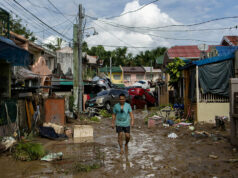Taal eruption’s impact on inflation to be minimal — DoF
THE Department of Finance (DoF) assured that the inflationary impact of Taal Volcano’s eruption will be minimal and manageable, its top official said Thursday.
“Although Batangas produces some of the food for Metro Manila, I think the damage, although it looks very bad now, I think that will be overcome by the production of food in other areas. I don’t think it will affect the inflation rate very very much. I think there will be some effect but not that much,” Finance Secretary Carlos G. Dominguez III told reporters on the sidelines of an event in Makati City when asked if Taal’s eruption would impact inflation.
On Wednesday, Philippine National Bank (PNB) economist Jun Trinidad said that recent natural disasters such as December’s typhoon and the Taal eruption, may cause inflation to spike to three percent year on year.
“While income and food price shocks arising from natural disaster events do not last given import channels and return to normal business/production in the affected regions, the recent natural disaster effects bolster a 2020 inflation trajectory that’s likely to breakout of the 2-2.5% range and perch at 3% year on year if not more, to kick start 2020,” he said in a note sent to journalists.
There are worries that food prices, particularly of chicken and pork, may rise as the Calabarzon Region — made up of Cavite, Laguna, Batangas, Rizal, and Quezon — is one of the major sources of livestock in the country. Taal Volcano is located in Batangas.
The government has set an inflation target range of 2-4% this year until 2022.
Data from the Philippine Statistics Authority (PSA) showed headline inflation stood at 2.5% in December 2019, the fastest pace since June’s 2.7%, although slower than the 5.1% in December 2018. Full-year inflation came in at 2.5%, within the central bank’s 2-4% target range and its full-year forecast of 2.4%.
While Calabarzon is known as a “big area for industrial development,” Mr. Dominguez said most of the products produced in the region are for exports.
“The importance there is it’s a big area for industrial development but most of those items are really exported, they are… mostly for exports,” the Finance chief said.
Mr. Dominguez said “the real problem” is how the eruption affected the lives and health of people, especially those in the devastated areas.
Since Sunday’s eruption began, over 82,000 people have been evacuated, and a 14-kilometer exclusion zone around Taal remains in place.
Socioeconomic Planning Secretary Ernesto M. Pernia earlier said the eruption and tremors is projected to record P7.63 billion worth of economic losses in Batangas alone as of Monday, which translates to 0.3% of Calabarzon’s total regional economic growth.
Initial estimates by the National Economic and Development Authority (NEDA) showed the services sector may suffer the most in terms of economic losses at around P4.32 billion due to Taal’s eruption, followed by the possible losses on agriculture, forestry and fishery sector at P3.28 billion and the industry sector which could lose around P27.16 million.
The Calabarzon Region had the second-largest contribution to the country’s gross domestic product (GDP) with a 17% share in 2018, next to the National Capital Region’s 36% share. — Beatrice M. Laforga



